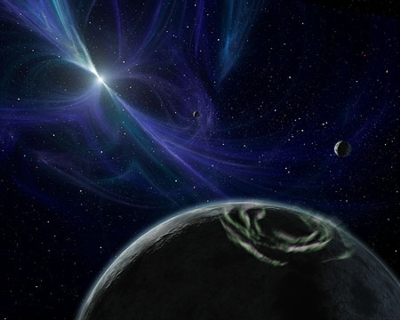Imagine the supernova leading to the formation of a pulsar. Also called a ‘neutron star,’ a pulsar is the remnant that survives the catastrophe. The explosion of a star at least 1.4 times the mass of the Sun leaves behind an object with a diameter of 10 miles, so dense that a teaspoon of its matter would weigh about two billion tons. It’s hard to see such a pulsar as the forming ground for a new planetary system.
But we know that such things happen, as at least one pulsar planetary system has already demonstrated. The pulsar PSR B1257+12 was found to have three planets orbiting it back in the early 1990s, two of them the size of the Earth. These were the first exoplanets ever discovered, and it seemed even then that they must have been created out of some kind of debris disk. After all, any planets originally orbiting a star that goes supernova will doubtless be incinerated, so pulsar planets are not survivors but entirely new worlds.

Image: This artist’s concept depicts the pulsar planet system discovered by Aleksander Wolszczan in 1992. The planets spotted by Wolszczan are still the only ones known to orbit a dead star. They also might be part of a second generation of planets, the first having been destroyed when their star blew up. The Spitzer Space Telescope’s discovery of a dusty disk around a pulsar might represent the beginnings of a similarly “reborn” planetary system. Credit: NASA/JPL-Caltech/R. Hurt (SSC).
But no one had ever observed a pulsar debris disk until recent work with the Spitzer Space Telescope apparently tracked one down. Researchers using Spitzer data have uncovered evidence that such a disk has formed around 4U 0142+61, a pulsar located 13,000 light-years away in Cassiopeia. The supernova that torched it and anything nearby took the life of a star that was anywhere from 10 to 20 times the size of our sun. And some of the debris from that extraordinary explosion now orbits the pulsar at its center, where it may eventually become the building blocks of a new planetary system.
“We’re amazed that the planet-formation process seems to be so universal,” said Dr. Deepto Chakrabarty of the Massachusetts Institute of Technology in Cambridge, principal investigator of the new research. “Pulsars emit a tremendous amount of high energy radiation, yet within this harsh environment we have a disk that looks a lot like those around young stars where planets are formed.”
So we may be looking at the early stages of the same kind of planet formation that occurred around PSR B1257+12. None of these worlds should be hospitable to terrestrial-style life, given the intense radiation in which they would be bathed, but what a story this is nonetheless. It seems to suggest that planets can form around almost any kind of star, with clear implications for the number of planets out there and the possibilities that some of them may come to support life.
The paper is Wang, Chakrabarty and Kaplan, “A debris disk around an isolated young neutron star,” in Nature 440, pp. 772-775 (6 April 2006), available here.


PSR B1257+12: a quark star with planets?
Authors: Youling Yue, Renxin Xu
(Submitted on 18 Sep 2007)
Abstract: A recent observation has shown that PSR B1257+12 could have quite small X-ray emitting area, only about 2000 m$^2$, which is more than three orders smaller than the canonical polar cap size. We suggest here that PSR B1257+12 could be a low-mass quark star with radius of $R \simeq 0.6$ km and mass of $M \simeq 3\times10^{-4}\msun$. Such a low-mass quark star system may form in an accretion induced collapse process or a collision process of two quark stars.
Comments: 3 pages, 1figure, poster at the international conference “Astrophysics of Compact Objects” (July 1-7, 2007, Huangshan, China)
Subjects: Astrophysics (astro-ph)
Cite as: arXiv:0709.2922v1 [astro-ph]
Submission history
From: Youling Yue [view email]
[v1] Tue, 18 Sep 2007 21:41:26 GMT (24kb)
http://arxiv.org/abs/0709.2922
The Pulsar Planets: A Test Case of Terrestrial Planet Assembly
Authors: Brad Hansen, Hsin-Yi Shih, Thayne Currie
(Submitted on 5 Aug 2009)
Abstract: We model the assembly of planets from planetary embryos under the conditions suggested by various scenarios for the formation of the planetary system around the millisecond pulsar B1257+12. We find that the most likely models fall at the low angular momentum end of the proposed range. Models that invoke supernova fallback produce such disks, although we find that a solar composition disk produces a more likely evolution than one composed primarily of heavy elements.
Furthermore, we find that dust sedimentation must occur rapidly as the disk cools, in order that the solid material be confined to a sufficiently narrow range of radii. A quantitative comparison between the observations and the best-fit models shows that the simulations can reproduce the observed eccentricities and masses, but have difficulty reproducing the compactness of the pulsar planet system. Finally, we examine the results of similar studies of solar system terrestrial planet accumulation and discuss what can be learned from the comparison.
Subjects: Earth and Planetary Astrophysics (astro-ph.EP); Solar and Stellar Astrophysics (astro-ph.SR)
Journal reference: ApJ 691, 382 (2009)
Cite as: arXiv:0908.0736v1 [astro-ph.EP]
Submission history
From: Brad Hansen [view email]
[v1] Wed, 5 Aug 2009 20:04:04 GMT (177kb)
http://arxiv.org/abs/0908.0736